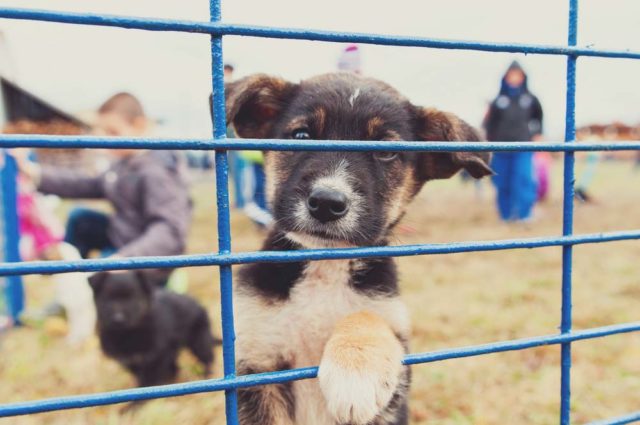
A researcher has just discovered stress reduction methods for dogs, which may finally aid in improving the homing of shelter animals.
One of the major issues all animal shelters and pet adopters have is the inability to determine a dog’s true temperament while the dog and potential adopter are both confined to the shelter. We've discussed this in a podcast interview with Richie Camden.
Basically, dogs are under constant stress when they're in these animal shelters and are surrounded by many other stressed-out animals. This can result in the dogs not being on their best behavior or exhibiting their true temperaments when adopters come around.
This, unfortunately, can result in two negative consequences: dogs either being put down for seemingly (but not innately) “bad behavior” or people adopting a dog who isn’t actually a good match for their home. Both cases are very common in pet adoption.
However, the results from a new study may help prevent these types of situations from occurring in the future and potentially find a better way for animal shelters and future adopters to find homes for rescue dogs and cats effectively. The study sought to determine what shelter dogs are like when they are afforded the chance to be away from the shelter.
The Study
The study was conducted by Lisa Gunter, who studies behavioral neuroscience at the Canine Science Collaboratory in the Department of Psychology at Arizona State University.

The project was started as a pilot study at Best Friends Animal Sanctuary in Kanab, Utah. Best Friends is America's largest no-kill animal shelter.
Approximately 1,600 cats and dogs reside at Best Friends and are visited by about 30,000 people each year. People take week-long “volunteer vacations” here, and guests are encouraged to take animals back to their hotel rooms with them overnight while they visit Best Friends pets.
Lisa Gunter’s study has concluded that sleepovers are immensely beneficial for dogs. It helps reduce their stress levels and reveal their true demeanor to people.
Gunter’s main goal in conducting this study was to determine whether or not the dogs’ behavior during the sleepover was predictive. She sought to find out whether one night out of the shelter would impact the dogs in any significant way.
The hope was that this would help determine what sort of behavior an adopter could expect to see from that dog once the dog was home.
During the study, Gunter measured the levels of the hormone cortisol which was present in the dogs – the most effective way to understand the level of stress in dogs. She also conducted a quick behavioral profile of each dog, asking questions such as:
- What is he like on a leash?
- What is he like when he sees another dog?
- How does he behave when you enter his kennel?
Researchers measured the cortisol levels of each dog at 3 points: the dog at the shelter, the dog during the sleepover, and the dog back at the shelter.
What They've Found
 Lisa Gunter was able to determine that one night spent away from the shelter resulted in dogs experiencing a significant decrease in cortisol levels. And importantly, their cortisol levels remained at this decreased level when they returned to the shelter the next day.
Lisa Gunter was able to determine that one night spent away from the shelter resulted in dogs experiencing a significant decrease in cortisol levels. And importantly, their cortisol levels remained at this decreased level when they returned to the shelter the next day.
People who took the dogs in for sleepovers observed a common trend: after each dog settled down, he or she would immediately take a long nap.
Gunter and her team supposed that the dogs were chronically sleep-deprived and that one of the contributors to their immediate stress reduction was the ability to finally sleep peacefully without being disturbed.
When the dogs experienced less stress, they were able to behave more naturally – more in tune with their innate temperament and usually more calm.
Let's think – how would we as people behave in similar real-life circumstances? If managers came to interview you for a job while you were in a prison cell, listening to all the other inmates yelling at you and never sleeping, you would likely find it difficult (if not impossible) to “show” well enough to get a job.
Gunter is carrying out her research in collaboration with another researcher at Carroll College in Helena, Montana. Recently, they were awarded a grant that will allow them to carry out this study at four different shelters across the U.S. And instead of getting just one day away, dogs will get two days.
Shelters nationwide struggle to get dogs into homes. They struggle equally with getting dogs into homes that won’t be returned later on.
This research could significantly reduce the instances of mismatched adoptions that occur and, therefore, reduce the prevalence of dogs being returned to shelters after adoptions go awry.
If you’re thinking about adopting a dog, ask the shelter if you can have several visits with the dog first. If the shelter can accommodate, ask if you can spend time off-site with the dog. This will give you a better indicator of the dog’s behavior.
Not every dog is perfect for you or your lifestyle. Like human relationships, canine companions must be in sync with our personalities in order for harmony to occur. Getting to know a dog when it isn’t in a high-stress environment is beneficial for both the adopter and the dog.
READ NEXT: 13 Helpful Tips for Rescuing a Dog from a Shelter












